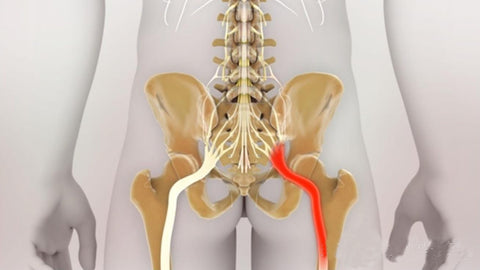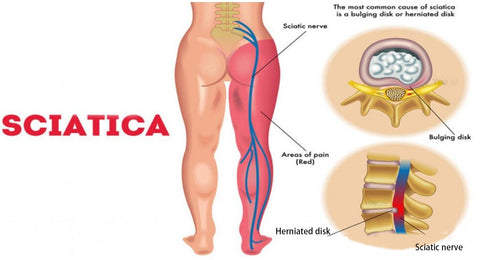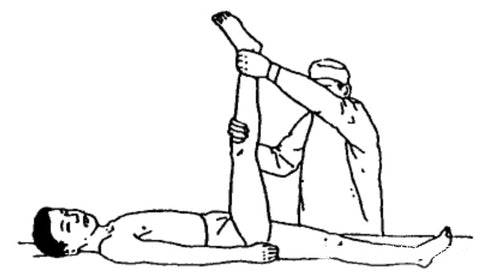Everything you need to know about sciatica is here
Sciatica is a very common clinical symptom, which occurs at least once in more than 40% of people in their lifetime. This condition is more common with age, especially in those with low back pain. Other risk factors include obesity, smoking, chronic stooping, weight bearing and a sedentary lifestyle
Sciatica is pain in the thigh, calf, and buttock caused by compression of the sciatic nerve. The sciatic nerve is a confluence of many smaller nerves that originate from the spinal cord at adjacent vertebral levels. They converge into the buttocks and then into the posterolateral thighs and calves. Compression of any part of the course of the nerve can cause pain and numbness in the area where the nerve goes.

Small nerves from each segment of the spinal cord converge to form the sciatic nerve, which runs along the buttocks to the lower extremity
Symptom
Patients with a compressed sciatic nerve often complain of numbness, pins and needles, or pain that begins in the buttocks and travels down the leg. Pain can be overwhelming and prevent you from functioning properly. Likewise, the pain can be mild, or somewhere in between.
This pain is usually worse when the person bends over, bears weight, and may occur with sneezing, coughing, or laughing. It can also happen at night. Because the sciatic nerve controls both feeling and function of the leg muscles, sometimes people also experience leg muscle weakness.

Causes of Sciatica
Lumbar disc herniation or slippage
Lumbar osteoarthritis includes the growth of bone spurs, ossification of intervertebral discs, and narrowing of the spinal canal. All of these can lead to narrowing of the intervertebral space or spinal canal, both of which put pressure on the small nerve roots that make up the sciatic nerve
Disc degeneration due to age-related changes
Spinal injury or spinal tumor
Gluteal muscle inflammation or pain
Piriformis syndrome
Why is exercise important in sciatica?
Most experts agree that moderate, non-strenuous activity and exercise will improve recovery from sciatica. This is because regular exercise strengthens the muscles that support the spine and prevents further disc herniation. In fact, as the muscles strengthen, the intervertebral space may widen, allowing more room for nerve roots to exit and less chance of being pinched.
Proper exercise is crucial to managing sciatica attacks. It ensures increased muscular strength over the affected joint capsule, while joint mobility becomes more supple. Pain can also be relieved in most cases.
Studies have shown that patients who continue to stay in bed for more than two days after a sudden onset of severe low back pain actually experience pain for longer than those who get up and move around. Therefore, the best advice for people with acute low back pain is to continue normal activities, but avoid prolonged weight-bearing activities or sitting in a fixed position, as this may exacerbate or relieve pain.
For patients with severe pain who cannot persist in exercising, anti-inflammatory and analgesic drugs can be taken orally for a few days to promote exercise.
Physical examination
To determine if a patient is suffering from sciatica symptoms, there are several common self-exams that can be performed. Muscle strength and reflexes are tested during the exam.
For example, patients may be asked to walk on their toes or heels and describe whether their pain is getting worse. Plus, for those with sciatica, getting up from a squatting position is often more painful.
The straight leg raise test is an excellent way to gauge the presence of sciatica. In this test, the patient should be asked to lie flat while raising the legs straight up, one leg at a time. If the process of raising the leg causes pain and other symptoms to worsen, it may be sciatica.

straight leg raise test
Auxiliary inspection
In most cases, the history and physical examination provide enough information to diagnose sciatica. However, some people exhibit special risk factors that require further testing to distinguish them from other conditions, such as infections, bone fractures, cancerous tumors, or cauda equina syndrome.
In these patients, radiographs are often used to determine the cause of symptoms and increase the likelihood of a correct diagnosis. These also apply to patients with severe or persistent symptoms.
Magnetic resonance imaging (MRI) can see cross-sectional images with detail of bones and soft tissues, including discs.
A computed tomography (CT) scan to see the spinal cord and nerves in this area.
An electromyogram (EMG), a test that measures electrical impulses produced by the nervous system, can provide information about narrowing of the spinal cord and lumen, as well as nerve damage.
Some patients may also require blood tests if the cause of the symptoms is unknown and a link to another medical condition is suspected.
Treat
Most people with sciatica experience significant improvement in the severity of their symptoms within 6 to 8 weeks. Therefore, the initial treatment should be as conservative as possible, and at the same time, the patient should be fully advised to understand the nature of the disease and take pain relief methods.
If other conditions are suspected to be involved, such as cauda equina syndrome, surgery should be performed immediately.
Initial proposal
During the initial consultation with a patient with sciatica, the patient is advised to continue normal daily activities as much as possible. Rest may relieve some symptoms, but does not help recovery.
Some people may find that applying hot or cold compresses is helpful for pain management. Cold compresses are recommended initially to help reduce pain and inflammation, followed by warm compresses two to three days later to reduce pain.
Proper stretching of the area can also reduce pain. In some cases, a physical therapist can help, or an individual can get help from simple yoga exercises. Continue to maintain moderate exercise, although exercise will not shorten the recovery time, it will help improve natural pain relief mechanisms, such as the release of endorphins.
Other important measures include:
correct posture
Firm mattress provides lumbar support
avoid bending over or lifting heavy objects
Pay attention to waist protection when sitting on a stool
changing positions or standing up from time to time
improve physical condition
Overweight can reduce weight


